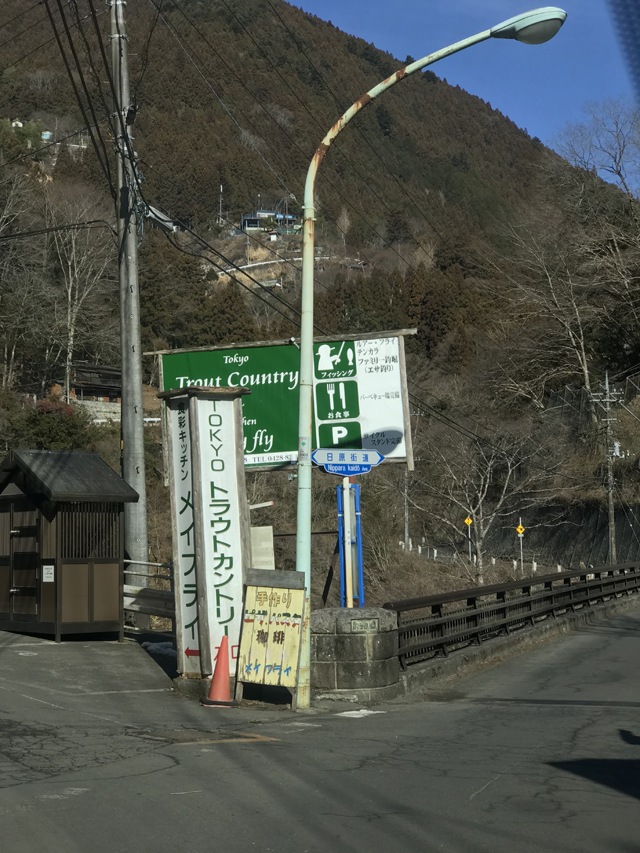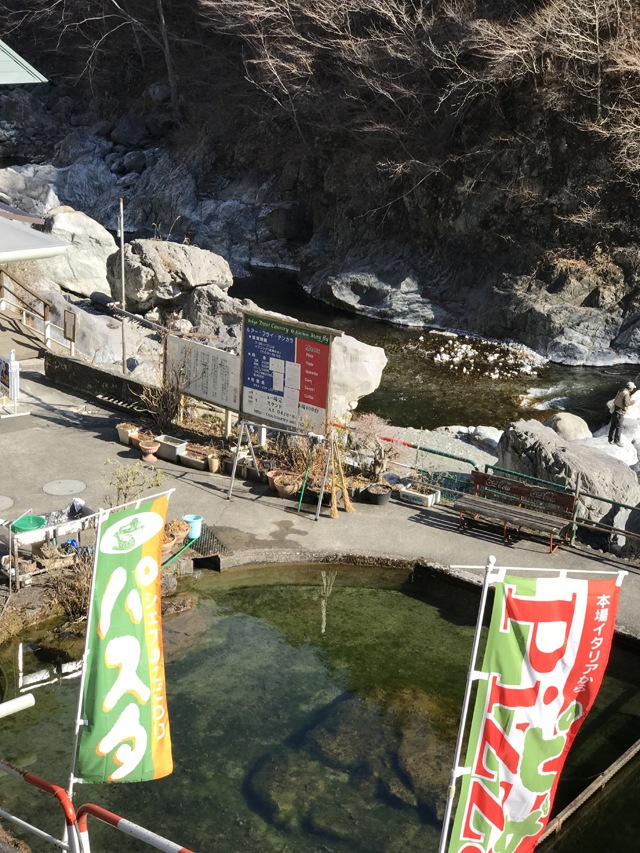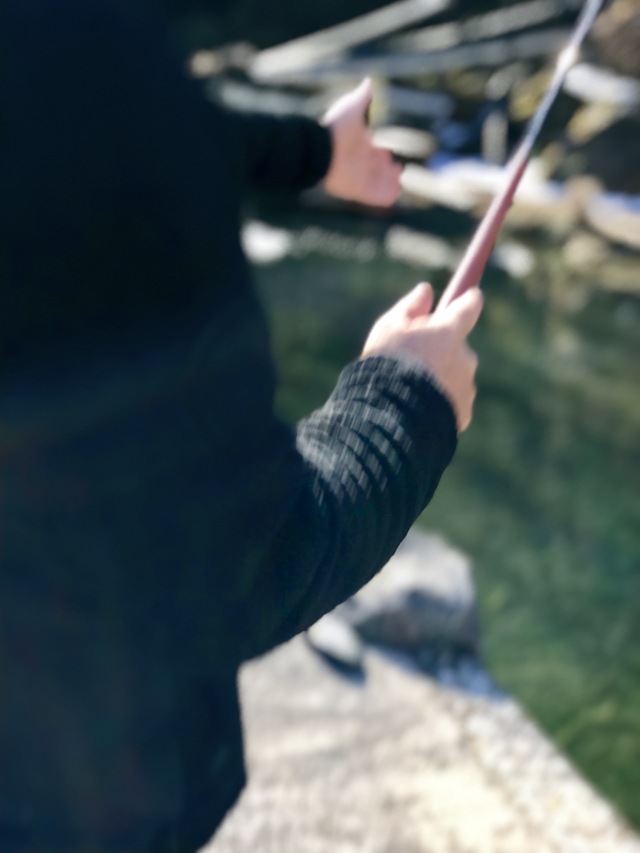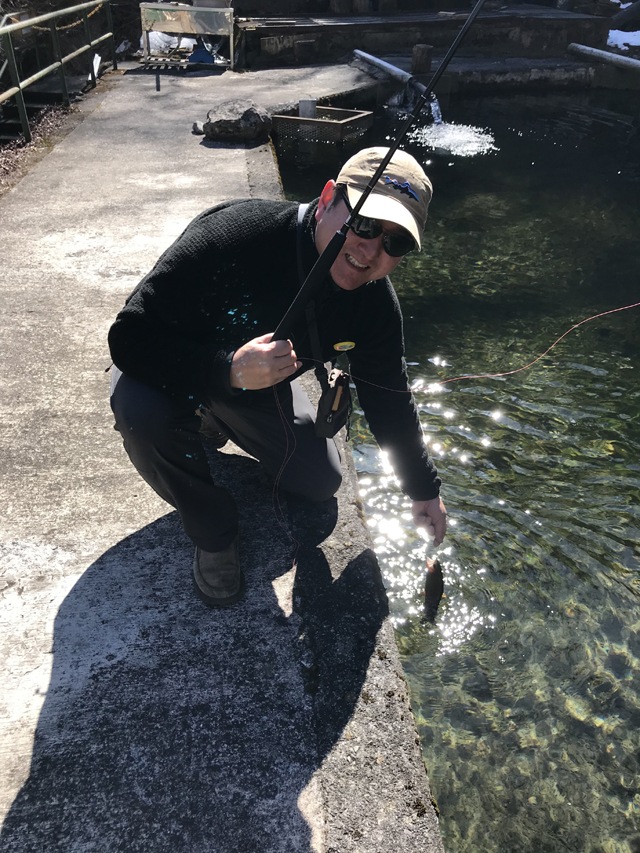Adam Rieger: Sake and Snow-bound Rivers
The official trip visiting Sake brewries ended in Kyoto on a Saturday. My hosts were going to be doing some business meetings on Sunday and then going to visit another brewery on there own in Gifu on Monday. I really wanted to visit this brewery as I love their sake (the brand in the US is known as Yamada Shoten “Everlasting Roots” if you want to find it :)) so they invited me to join. Sadly the brewery is not located in the hollowed areas for tenkara in Gifu…

So…I was free on Sunday. I had wanted to fish in Japan and I think Go-san instinctively knew that. He had to deliver to me the bad news that February is not a good time of year to fish in Japan. Some places are closed to fishing, many are completely inaccessible due to snow and ice and others well are pay to fish places with stocked rainbow trout. The best time of year to visit for keiryu stream tenkara is probably July. For genryu tenkara it is probably September…well I will have to go back at one of those times of the year!
I chatted with Go-san on the phone prior to leaving the states and he told me about a place approximately 2 hours drive from Tokyo city center called Tokyo Trout Country. This is a pay to fish place that has both a trout pond and a small section of water with mostly stocked rainbows but a small chance for native fish. He explained to me that the fishing would be very slow and very difficult but if the weather cooperated and the roads were not closed we could do it. I thought about it for maybe 1/2 a second and said yes. For me, catching a fish was really not the important part, but the opportunity to learn from a master was…rainbows or fish activity was really irrelevant.

So the weather held out for us and we made the trip. We ended up sharing the place with one other tenkara angler that Go knew (he was doing quite well catching both native and stocked fish actually using clear flourocarbon level line so as not to spook the fish) and a spin fisherman who was struggling to get his lure to the proper depth with the currents and retrieve needed to not get hung up.
Beginning to Fish
We began from scratch and on the trout pond. Go-san set up his legendary Daiwa Rinfu 450 cm rod and we got to casting. I eventually traded over to his Karasu 360 because well I wanted to try out the Karasu! Let’s just say it was a humbling experience…a master is well a master…and I was blown away by the ease and skill at which Go was able to fish. My home stream’s posses much more tree and plant cover on the banks and over the streams. They also have less large rocks and less plunge character. The stream we fished had no casting issues other than if a boulder was behind you. The individual sections of the stream were also more complex than my typical home stream. In particular the currents, so reading the water presented some new challenges.

Go set up the 360 Karasu with about 6 meters of 2.5 level line, 4 feet tippet and standard soft hackle kebari. I tend to fish a much shorter set up…typically a line and tippet a bit longer than the rod. Go explained that I should really practice with a long line. The long line has no forgiveness for lack of technique and so by practicing that way you develop proper muscle memory and build your skill. When you go fishing if you use a shorter line you will then find your accuracy and confidence much better. He also suggested practicing on a pond with a very visible kebari (hook cut off) so you not only practice casting but also manipulations and see how the kebari moves in the water.

Well after time on the pond and a few Asahi we hit the stream. Many of the things are learned are not so easy to cover with words but I will try to list them below. A lot of what I learned and list below is shown in video form or diagram by the Discover Tenkara guys (see below). I will say many of those videos and diagrams I had seen before and yet working with someone teaching them “live” and in person was not only much more impactful it actually helped me really understand them. I cannot say enough how we can surely catch fish doing things on our own…but if we fish with other anglers with great skills we can learn much more!
Casting
- Relax! A tenkara rod is very sensitive and is a great transmitter of all movement in your arm. If you are stiff or tight that will resonate down the rod…that is no good! Relax..stay loose!
- The harder you try to cast or the more you “force” a cast the worse it will be. This is again to the “relax” point.
- Casting is all about “Rhythm” with the flex of the rod. More about timing than energy or strength.
- In casting the so called “stop” is more of a transition point in the cast not an actual stop…you do not pause and wait but change direction.
- The “pick up” part of the cast sets the tone…
- To cast a long line you need “line speed’ and that is generated by a faster rhythm not stronger force.
- Back cast is more a pickup…think about shooting the line up not back. You can even twist your wrist up for back down for forward.
- The casting arm: You use no wrist. Elbow close to body…elbow is the hinge and only forearm moves back and forth like throwing a dart.
- For full distance when casting you need to follow through further…go past the 10 o’clock to parallel to the ground. As the line extends the full distance past the rod tip begin to raise the rod back. Altering this forward “stop” changes the distance.
- Wind – cast on the side of your body that the wind is on. So if the wind is coming from your right cast the line on the right side of your body and rod. Left on the left.
Reading the Water and techniques to get the fly to those places
- Work a section not only thinking of standing position and stealth but also currents so that you deliver fly first. So if current flows upstream at a spot you might need to change your order of fishing spots so that you don’t “line” a section that might hold a fish.
- Think of the tip of the rod to do mini “swings” of the fly or to “change lanes” in currents. – – Undercut banks or under rocks are great places to find a fish…so if you drift near there and then stop following you can get the fly to swing under the bank or rock. Likewise in a current if you want to “change lanes” you can use the rod tip to add tension and swing the line into the lane you want and then follow again.
- Use rocks or river obstacles to help tome zuri or to get the fly to be pulled under them. For example as a fly drifts downstream toward you resting the line on a rock will cause the fly to swing under the rock.
- “Bank shot” if you have an overhanging rock and no space to side arm cast the fly under it you can cast so that the middle of you tippet hits the rock and bounces the fly underneath.
General Stuff
- Double hook set. Always. The first “hook set” is likely a manipulation as the fish will take on the pause and you will feel it on the manipulation so follow with a second firm set.
- Fish with you feet. Move and cover ground don’t keep fishing in the same “prime spot” for too long. When playing a fish also move to help maintain proper tension.
- When fishing after someone on a stream…try to see what they did and do something different.
- To sink a fly the tippet needs to hit the water on the cast so it breaks surface tension. If you cast fly first then tippet will hold in surface tension longer.
I am sure I am forgetting many things, but if I can figure out how to actually do all these things I will be able to really up my game!
Adam Rieger, Feb 28th, 2018
Editor’s note: Many thanks to Adam again for allowing us to share his insights, memories in his words and photos – you can catch Adam’s third instalment very soon!
If you want your own Virtual online course with Go Ishii (with an onstream tuition session followed by many technical breakdowns in diagrams and text) CLICK HERE TO FIND OUT MORE.
